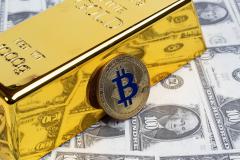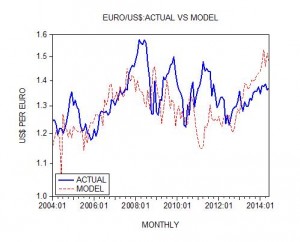Source: https://mises.org/wire/world-growing-tired-government-controlled-fiat-currencies Listen to the Audio Mises Wire version of this article.
Here in the U.S. the financial markets are focusing on Fed Chair Jerome Powell’s herky-jerky monetary messages while politically the news is Trump’s two picks for the central bank board have taken themselves out of the running.
Herman “9-9-9” Cain and Stephen Moore couldn’t take the heat and either withdrew their names from consideration, or their names where withdrawn via twitter. Both had plenty of baggage, but, what the two had in common was, in their pasts, mentions of returning to the gold standard. That is a no-no. Washington is full of #metoo offenders, but kooky #goldbugs are not allowed.
That kind of talk garners a bipartisan 86ing from serious contention.
Meanwhile, Sputnik News reports that Russia (Vlad and Elvira, Russia’s central bank head) continues to ditch dollars in favor of the ancient relic that Washington so despises.
The new purchases continue a trend established at the start of the year, with Russia buying a whopping 31.1 tonnes in February, adding to 6.22 tonnes purchased a month earlier. Russia has now bought some 55.98 tonnes of gold in the first three months of 2019, putting it well on track to matching the average 200+ tonne purchase made annually over the past half-decade.
One wonders what Mr. Putin and Ms. Nabiullina, are up to? By the way, Ms. Nabiullina is not just a pretty face, she was named the best Central Bank Governor in Europe in 2016 by the international financial magazine, The Banker, besting the likes of Mario Draghi.
Her gold buying makes me think she has read Saifedean Ammous’s The Bitcoin Standard: The Decentralized Alternative to Central Banking. Don’t let the title fool you. This book is not the cover-to-cover crypto cheerleading/gold bashing other authors attempt to jam down our throats. Dr. Ammous Is actually a Professor of Economics, and none other than “Black Swan” author Nassim Taleb wrote the introduction.
Professor Ammous’s Tour de Force begins where it should; the origins of money, then monetary metals, the government takeover of money, time preference, Austrian business cycle theory, money and freedom, and finally digital money. For those wanting to know what the heck a Bitcoin is, it may seem like a long wait. Changes in money don’t happen overnight. All of your questions about Bitcoin are answered in Chapter 10. However, with a bibliography loaded with Hoppe, Higgs, Hazlett, Mises, Raico, and Rothbard, don’t skip ahead.
If one didn’t know the title, a reader would swear Professor Ammous is making the case for a return to the gold standard: Not a phony Bretton Woods gold standard, but the real pre-WWI gold standard deal.
What makes gold such a great monetary metal is it’s high stock-to-flow ratio. The author explains all the gold ever mined, a thousand years worth, is still with us. So, gold’s price elasticity of supply is the lowest of any metal. However, with Satoshi Nakamoto’s protocol capping the number of Bitcoin at 21 million, it’s elasticity of supply is even lower.
Anyone who has held a one ounce gold coin knows that transporting any amount of the metal is cumbersome. Thus, paper receipts for the metal generally changed hands and the gold stayed put. Of course, the paper began to trade backed by less and less gold, and here we are. Since Nixon snipped the last thread tying the dollar to gold, the number of dollars has grown exponentially. The gold standard is great, except in the hands of untrustworthy governments, ie. any and all governments.
Satoshi, whoever he, she, or they may be, published the Bitcoin paper in 2009, a response to the 2008 financial crash. However, Professor Ammous, references a book by James Davidson and William Rees-Mogg entitled The Sovereign Individual. A book well known in libertarian circles. What Ammous points out is Davidson and Rees-Mogg foresaw Bitcoin technology 12 years prior to Satoshi’s work. They, Ammous writes, “predict with remarkable prescience the form that the new digital monetary escape hatch will take: cryptographically secured forms of money independent of all physical restrictions that cannot be stopped or confiscated by government authorities.”
Bitcoin is a shot across the bow at government’s monopoly control of money. While no one in the US appreciates the direction money is going, having the world’s reserve currency and all, Vladimir Putin and Elvira Nabiullina can see what Professor Ammous understands,
If the modern world is ancient Rome, suffering the economic consequences of monetary collapse, with the dollar our aureus, then Satoshi Nakamoto is our Constantine, Bitcoin is his solidus, and the Internet is our Constantinople.
“The current fiat money system that originates from 1973 may be replaced by digitalised commodity-based currencies in the future,” Marc Friedrich, a German economist and bestselling author, told Sputnik.
The Bank of International Settlements will introduce a rule on January 1, 2022 allowing central banks to hold up to 20 per cent of their deposits in gold, silver, and even platinum in order to stabilize their balance sheets, according to Friedrich.
Bloomberg reports central bank gold buying in the first quarter was the highest in six years led by China and Russia. Rupert Rowling writes,
Global gold reserves rose 145.5 tons in the first quarter, a 68 percent increase from a year earlier, the World Gold Council said Thursday in a report. Russia remains the largest buyer as the nation reduces its U.S. Treasury holdings as part of a de-dollarization drive.
Rowling continues,
The buyers are dominated by countries looking to reduce their dollar dependency, and are typically nations with a lower share of reserves in gold than Western European countries.
The battle is joined: Central Banks and the fiat reserve dollar hegemony won’t give up easy, even resorting to a return to precious metals to stave off the threat of individual monetary sovereignty, Bitcoin, and the digital revolution.




LOL
For the record,
UNLESS the government (in reality) is issuing ALL the money of a nation, and with a fully owned and controlled central bank, THEN there is no ‘government-controlled fiat currencies’ in the world, from which the world could ‘tire’.
There seems some conflation between the $US serving as the, more or less, global reserve currency and a government-controlled fiat currency.
In that regard, first, it’s long past time for the global petrol / reserve relationship to end … all for that …..but, second, when was the last time the government US controlled ANYTHING to do with the private Federal Reserve System operations?
Our government RENTS money services FROM the central bank, and our government BORROWS from national and international bankers, and our government pays interest to FR banks that can purchase our debt with interbank play money, and then can also BOROW from the Restofus ….. hardly the mark of being in control.
No, in reality, the world pines for a true government-issued fiat currency.
And the end of central banking as we know it.
It’s not fiat currencies that is the problem.
It is:
1. Government control as opposed to electing an independent body to cap money creation.
2. Allowing banks to multiply the stock of money circulating. The way to end that is to have a note of which deosits have been lent and not permit them to be lent twice. Use a spreadsheet with a column for each.
3. Then there is a shortage of deposits for lending. So to avoid having interest rates managed by the government / central banks and to optimise theuse of the limited supply of credit
The central banks hold daily auctions of deposits that they create. The deposits are allocated to the highest institutional bidders. They know who caan best use the credit they have to onlend.
And the supply is limited by the cap – item 2 above.
NO ONE KNOWS how much money is needed and the amount vares all the time. One guide will be the auction bid rate of interest. Another will be the rate of growth of economic output.
But all that will sort itself out if the money creation limit is set at a reasonable level such as 4% or 6% p.a. for a developed economy. A steady rate of creation is one option.
The problems that remain are mostly related to the structure of debt. The home loans and the fixed interest bonds inject instability into the economy when money varies in value as it always does and always will.
So read about the solutions for that which can be found on my blog http://macro-economic-design.blogspot.com
Then a variable value of money saves us from trying to understand exactly how much to create. It doesn’t really matter, up to a point.